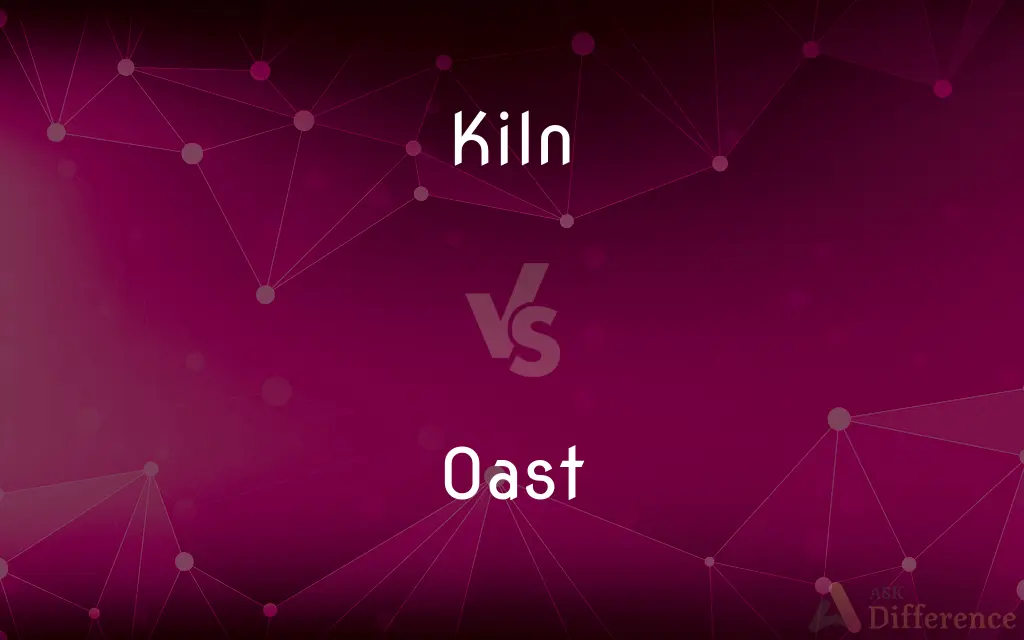Kiln vs. Oast — What's the Difference?
By Maham Liaqat & Fiza Rafique — Updated on April 23, 2024
Kiln is primarily used for firing or drying materials like clay, while an oast is specialized for drying hops or malt.

Difference Between Kiln and Oast
Table of Contents
ADVERTISEMENT
Key Differences
Kilns and oasts serve the fundamental purpose of drying, but their specific uses and construction reflect their specialized applications. A kiln, widely recognized in industries ranging from pottery to brickmaking, operates at high temperatures to transform or cure materials. An oast, on the other hand, is specifically designed for drying hops used in brewing beer, as well as malt and other agricultural products. The distinctive feature of an oast house, especially traditional ones found in England, is its conical or pyramidal roof with a cowl that turns with the wind to draw air through the building.
The energy source and temperature control in kilns and oasts are tailored to their specific purposes. Kilns often use gas, electricity, or wood as energy sources, and temperature control is critical for achieving the desired chemical and physical transformations in the material being processed. In contrast, oasts traditionally relied on a steady, gentle heat often provided by wood or coal, with modern versions using more controlled heating methods to ensure the hops are dried evenly without being overcooked.
The architectural design of kilns and oasts reflects their functionality. Kilns are designed to contain and maintain high temperatures efficiently, with insulation and refractory materials being key components. Their structures can range from simple, such as pit kilns, to complex, like tunnel kilns, depending on the scale of operation and the uniformity of heat required. Oasts, particularly historic ones, have a distinctive look that includes roundel buildings and the iconic cowls on their roofs, which are not just functional for ventilation but also serve as a symbol of the hop-growing regions where they are found.
The cultural significance of kilns and oasts varies, with kilns playing a crucial role in numerous cultures for thousands of years due to their importance in crafting everyday and artistic items. Oasts, while more niche, hold a special place in the history and tradition of hop cultivation, particularly in regions like Kent and East Sussex in England, symbolizing the heritage of brewing.
Comparison Chart
Primary Use
Firing or drying clay, ceramics, bricks
Drying hops or malt for brewing
ADVERTISEMENT
Temperature
High temperatures for firing
Lower temperatures for drying
Design
Varied, depending on material (e.g., rotary, chamber)
Typically features a conical or pyramidal roof with a cowl
Energy Source
Gas, electricity, wood
Traditionally wood or coal, modern versions may vary
Cultural Significance
Crucial in crafts and construction for millennia
Important in hop cultivation and brewing heritage
Compare with Definitions
Kiln
High-temperature oven.
The artist carefully placed her pottery in the kiln, hoping for a perfect glaze.
Oast
Dries hops for brewing.
The freshly picked hops were spread out in the oast to dry.
Kiln
Used for firing ceramics.
The new kiln allowed potters to experiment with different firing techniques.
Oast
Features a unique roof design.
The oast's conical roof is an iconic feature of the landscape in hop-growing regions.
Kiln
Can dry lumber.
The kiln dried the lumber quickly, making it ready for construction.
Oast
Used in beer production.
The oast played a crucial role in preparing the hops for the brewery.
Kiln
Varies in design.
Industrial kilns are much larger than those used by hobbyists.
Oast
Symbol of brewing heritage.
The old oast house is now a museum dedicated to the history of brewing.
Kiln
Ancient technology.
Archaeologists discovered a kiln that was used to make pottery thousands of years ago.
Oast
Historically powered by wood or coal.
In the past, the oast was heated with a carefully managed wood fire.
Kiln
A kiln is a thermally insulated chamber, a type of oven, that produces temperatures sufficient to complete some process, such as hardening, drying, or chemical changes. Kilns have been used for millennia to turn objects made from clay into pottery, tiles and bricks.
Oast
A kiln for drying hops or malt or drying and curing tobacco.
Kiln
Any of various ovens for hardening, burning, or drying substances such as grain, meal, or clay, especially a brick-lined oven used to bake or fire ceramics.
Oast
(British) A kiln for drying tobacco, malt and especially hops.
Kiln
To process in one of these ovens.
Oast
A kiln to dry hops or malt; a cockle.
Kiln
An oven or furnace or a heated chamber, for the purpose of hardening, burning, calcining or drying anything; for example, firing ceramics, curing or preserving tobacco, or drying grain.
Oast
A kiln for drying hops
Kiln
To bake in a kiln; to fire.
When making pottery we need to allow the bisque to dry before we kiln it.
Kiln
A large stove or oven; a furnace of brick or stone, or a heated chamber, for the purpose of hardening, burning, or drying anything; as, a kiln for baking or hardening earthen vessels; a kiln for drying grain, meal, lumber, etc.; a kiln for calcining limestone.
Kiln
A furnace for burning bricks; a brickkiln.
Kiln
A large oven for firing or burning or drying such things as porcelain or bricks
Common Curiosities
What's the difference in temperature between kilns and oasts?
Kilns operate at higher temperatures suitable for firing ceramics or drying lumber, whereas oasts use lower temperatures to gently dry hops.
What is the main purpose of a kiln?
A kiln is primarily used for firing or drying materials like ceramics, clay, and lumber.
What does an oast house do?
An oast house dries hops or malt, which are used in brewing beer.
Are oasts still used today?
Yes, oasts are still used, especially in traditional hop-drying processes, though modern technology has introduced more efficient methods.
What types of energy sources power kilns?
Kilns may be powered by gas, electricity, or wood, depending on the specific requirements of the material being processed.
Can you visit an oast house?
Many oast houses, especially those no longer in use, have been converted into museums or cultural heritage sites.
What innovations have been made in kiln technology?
Modern kilns offer precise temperature controls and energy efficiency, catering to a wide range of industrial and artistic needs.
Can kilns be used for purposes other than pottery?
Yes, kilns can also be used for drying lumber, processing metals, and making bricks.
Why do oasts have unique roofs?
The unique roofs and cowls on oasts facilitate ventilation and ensure even drying of hops.
What is the significance of kilns in history?
Kilns have been essential in various cultures for thousands of years, pivotal in creating pottery, bricks, and other materials.
Is there a specific location where oasts are more common?
Oasts are commonly found in hop-growing regions, such as Kent and East Sussex in England.
How do the designs of kilns and oasts differ?
Kilns vary widely in design based on their use, while oasts are specifically designed with conical roofs for hop drying.
How has the design of oasts evolved?
While traditional designs are preserved for historical value, modern oasts may incorporate advanced technology for better efficiency.
What cultural role do kilns and oasts play?
Kilns are integral to the heritage of crafts and construction, while oasts symbolize the tradition of hop cultivation and brewing.
How does the operation of an oast contribute to beer quality?
The gentle drying process in an oast preserves the hops' aroma and flavors, essential for producing quality beer.
Share Your Discovery

Previous Comparison
Process vs. Sequence
Next Comparison
Sonata vs. AriaAuthor Spotlight
Written by
Maham LiaqatCo-written by
Fiza RafiqueFiza Rafique is a skilled content writer at AskDifference.com, where she meticulously refines and enhances written pieces. Drawing from her vast editorial expertise, Fiza ensures clarity, accuracy, and precision in every article. Passionate about language, she continually seeks to elevate the quality of content for readers worldwide.











































